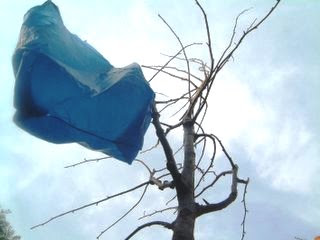 Turquoise Bag in a Tree is an ongoing project which focuses on the environmental impact of plastic carrier bags. The project began 2003 and includes video, photography, events and interventions in public spaces. See below and follow the link to www.turquoisebaginatree.com to see this work on line.
Turquoise Bag in a Tree is an ongoing project which focuses on the environmental impact of plastic carrier bags. The project began 2003 and includes video, photography, events and interventions in public spaces. See below and follow the link to www.turquoisebaginatree.com to see this work on line.
Turquoise Bag in a Tree, video, The Bigger Picrure, Exchange Square, Manchester
For the launch of The Bigger Picture Commissions, canvas bags were offered to those attending the preview and to passers by in a "Plastic Bag Amnesty" in the street. Collected and found turquoise bags are being added to "Rope" (see below). By using the canvas bag in replace of a plastic one when you shop, you have the capacity to eliminate thousands of plastic bags in its lifespan.

Rope, donated plastic bags made to form a rope

I have made some oversized carrier bags which appear anonymously in public spaces from time to time. The giant bag appeared in and around Manchester during the The Bigger Picture commission and will feature in a new video work, The Shopper.
The Shopper is a video work in progress which explores the economics of the high street and asks the viewer to consider their own accumulaion of material goods in a lifetime of shopping.
Contemporary Art and The Contemporary Past:
Hilary Jack showing on The Bigger Picture
For an archeologist, Hilary Jack's Turquoise Bag in a Tree" showing on The Bigger Picture as commissioned by Cornehouse,
Garbage
Notions of garbage, trash, junk are at the heart of this work: the excess of forgotten, discarded objects generated through the material practices of everyday life. These thin, translucent, empty bags appear to have outlived their usefulness, have been discarded as waste products. They are usually invisible or passed over, but Jack’s work documents their continued presence, their afterlives. We are surprised that they’re still here. They have not been pressed into landfills but, thrown away, have escaped on the breeze, filled and lifted up like kites, slipping from the fingers and spiraling above our heads. Superfluous, tattered and windblown, they cling to the branches of municipal trees like awkward, rustling windsocks. By engaging with garbage, the work acknowledges context – documenting through film where these scraps of carrier bag survive. Jack’s practice serves to document the shifting situations of these plain bags, and of the artist’s material engagements (cf Doherty 2004). Jack re-uses and recycles these hopeful scraps of plastic. She deals like Bill Rathje’s ‘Garbage Project’ at the Staten Island landfill,
Consumerism
Meanwhile, there is a quiet activism to the project’s engagement with consumption and environmental concerns. Plastic carrier bags are commonplace, everyday items. Their textures, sounds, stretchability, how they pull heavily at our arms as we walk home, are all familiar. Yet here, they are presented as the messy remains of consumerism – empty containers for carrying things from one place to another, discarded en route. Jack reminds us that they will resist transformation and decay for hundreds of years. She raises the environmentalist critique of an unsustainable consumer culture by examining what survives from thousands of momentary purchases, ephemeral moments. This challenges the boundaries of what we define as refuse: the attitudes that Ellen Lupton and Abbott Miller, in their studies of changing domestic interiors, called ‘the aesthetics of waste’ (1992). The artist’s critical interventions have a delicate politics to them: one that critiques throwaway material culture, while at the same time recognizing its strange, affective powers.
Enchantments
We might imagine that modern, industrial processes of commodification have drained from the world of objects any sense of enchantment – leaving only homogenizing and deluding ‘culture industries’. Material culture studies increasingly challenge such perspectives through the notion of object agency. Ethnographers have explored the nature and limits of the power of objects (especially art objects) in social life (Gell 1998). Prehistorians working on ‘rubbish pits’ have recognized the aesthetics of many depositional practices in the past (Pollard 2001). In contemporary archaeology, and in Jack’s contemporary art, the ‘enchanting’ nature of objects is present not just in distant ethnographic or prehistoric situations, but all around us in the detritus of the contemporary world. Jack documents taphonomic accidents rather than purposeful assemblages – the stuff that remains. Her knotted rope of turquoise bags hanging from a sixth-floor balcony evokes contemporary fairy tales. In its archaeological encounters, Jack’s work invites us to extend complex intentionalities to nonhuman objects (not just to humans). The bags arrange themselves in trees. They dance in the wind. They withstand degradation. They resist fragmentation. This is what Jane Bennett (2001: 14) has called ‘enchanted materialism’: the refuse is animated, enchanting, ineffable. Unsettling and compelling for an archaeologist: a timely reminder of the common ground that is shared between contemporary art and contemporary archaeology: the contemporary past.
http://www.bris.ac.uk/archanth/staff/hicks.html
© 2005 Dan Hicks
Bennett, J. 2001. The Enchantment of Modern Life: Attachments, Crossings and Ethics..
Bradley, A., V. Buchli, G. Fairclough, D. Hicks, J. Miller and J. Schofield (eds) 2004. Change and Creation: historic landscape characterization 1950-2000. http://www.changeandcreation.org/
Buchli, V. and G. Lucas 2001. Archaeologies of the Contemporary Past.
Doherty, C. 2004. The New Situationists. In C. Doherty (ed.) Contemporary Art from Studio to Situation.
Gell, A. 1998. Art and Agency.
Lupton, E. and J.A. Miller 1992. The Bathroom, the Kitchen and the Aesthetics of Waste: A Process of Elimination.
Pollard, J. 2001. The Aesthetics of Depositional Practice. World Archaeology 33(2): 315-33.
Rathje, W. and C. Murphy 1992. Rubbish! The Archaeology of Garbage.
Shanks, M. 2005. Archaeologies of the Contemporary Past. http://traumwerk.stanford.edu/~mshanks/traumwerk/index.php/Archaeologies%20of%20the%20contemporary%20past(accessed 14 march 2005) vj




